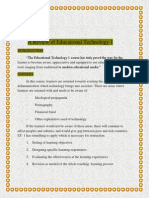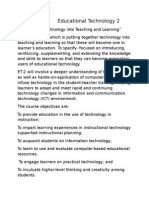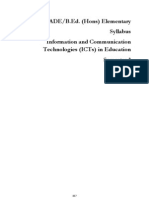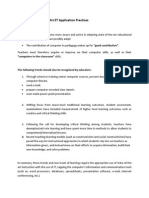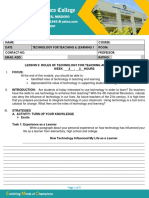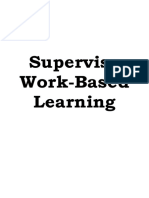Ed Tech 2
Ed Tech 2
Uploaded by
Joviner Yabres LactamCopyright:
Available Formats
Ed Tech 2
Ed Tech 2
Uploaded by
Joviner Yabres LactamOriginal Description:
Original Title
Copyright
Available Formats
Share this document
Did you find this document useful?
Is this content inappropriate?
Copyright:
Available Formats
Ed Tech 2
Ed Tech 2
Uploaded by
Joviner Yabres LactamCopyright:
Available Formats
JOVINER Y.
LACTAM
EDUCATIONAL TECHNOLOGY 2
Lesson 1: Review of Educational Technology 1
Content:
Lesson 1 tackles about the Review of Educational Technology 1. The EdTech 1
course as stated has paved way for students to become are, appreciative and equipped
to use educational technology ranging from traditional to modern educational media.
This course served to orient the learner to the pervasiveness of Educational technology
in society, lend familiarization on how educational technology can be utilized as media
for the avenues teaching learning process in school, uplift the learner to human learning
through the use of learning technology etc. The course has also given us the
opportunity to experience engaging ourselves more with technology use.
Experience:
We experienced using Photo story, creating exams through quiz maker etc. One
of the best feature of this course is the hands-on activities given to us which allow us to
apply the things weve learn during lectures.
Reflection:
This topic has given us a short review on Educational Technology 1 which also
let us recall the things tackled in Edtech 1 and eventually be applied in EdTech 2.
Application:
EdTech 2 will serve as the continuation of EdTech 1 that will basically help us in
preparing ourselves for a globally competitive world.
Lesson 2: An Overview: Educational Technology 2
Content:
Lesson 2 tackles about the overview of Educational Technology 2. It is concerned with
integrating technology into teaching and learning. This focuses on introducing,
reinforcing, supplementing and extending the knowledge and skills to learners so that
they can become exemplary users of educational technology. Educational Technology 2
will involve a deeper understanding of the computer as well as hands-on application of
computer skills. The course is directed at enhancing teaching-and-learning through
technology integration. The lesson had also presented the course objectives like
providing education in the use of technology in instruction by providing knowledge and
skills on technology integration-in- instruction to learners, impart learning experiences in
instructional planning, learn to use and evaluate computer-based-educational
resources, etc.
Experience:
This course allows us to experience new things like doing/ learning how to use
print screen, copy and paste it to MS word or MS PowerPoint.
Reflection and application:
As said, the topic allows us to realize that this course enhance teaching-and-
leaning through technology integration which will be later applied in teaching students in
a more fun and exciting way.
Lesson 3: Educational technology in the Asia Pacific Region
Content:
This lesson is all about the Educational Technology in the Asia Pacific Region.
During the last few years, progressive countries in the Asia Pacific Region have
formulated state policies and strategies to infuse technology in schools. This is concern
with the pervasive awareness that a nations socio-economic success in the 21
st
century
is linked to how well it can complete in a global information and communication
technology (ICT) region. Nations has therefore given tremendous responsibilities on
educators to create an educational technology environment in schools. Focus areas on
educational technology environment in schools. Focus areas are infrastructure of
increasing schools access to ICTs to enhance education and professional development
so that school managers and teachers can increase their capacities to use ICT.
Experience:
As what we have observed in our country, most of the people here think that our
country isnt improving so what with countries like Africa, Cambodia which have lesser
facilities of technology? This is according to my research.
Reflection:
This lesson would help us realize and motivate ourselves with what the other countries
are doing with their Information Technology (I.T).
Application:
The real essence of this topic depends on how the learners apply what theyve learned
in this lesson.
Lesson 4: BASIC CONCEPTS OF INTEGRATING TECHNOLOGY IN INSTRUCTION
Content:
A lingering issue arises on how Educational Technology is integrated in the
teaching-learning process. This is in line with the fact that the mere use of computer
does not mean technology has already integrated in instruction. It is also said in this
lesson that there is NO INTEGRATIVE PROCESS say for instance; the teacher lets
students play computer games to give them a rest period during classes. There are also
external manifestations of technology integration tackled in this lesson. Here are some:
Theres a change in the way classes are traditionally conducted; The quality of
instruction is improved to a higher level in such a way that could not have been
achieved without educational technology; The teacher sets instructional strategies to
address specific instructional issues or problems; and The use of technology provides
the opening of opportunities to respond to these instructional issues or problems.
Experience:
As an experience, I heard issues from the college of Engineering about students
taking up computer laboratory class (especially boys) were playing games like DOTA
etc. instead of doing things that relate s to the computer subject lectures. It is said in
this lesson that there is no integrative process if the teacher lets students play computer
games to give them a rest period during classes.
Reflection:
The concepts stated in this lesson are also acceptable basing on the real aims
of Educational Technology. This lesson clearly sets the basic concepts of integrating
technology in instruction. These concepts could basically help us for future application.
Application:
As a future educator, I will set in mind to conduct activities that relates or
connects to the subject-matter itself. Students should not be abusive with the use of
technology that they end up focusing only on computer games rather than important
issued on computer.
Lesson 5: STATE- OF-THE-ART ET APPLICATION PRACTICES
Content:
This lesson tackles about how our educators today have become more aware
and active in adopting state-of0the-art in Educational Technology. Here are some
practices they can adopt: Greater needs for teachers to acquire not only computer
literacy but competence; Technologies before are not so obsolete today; changes in
pedagogical theory and practice; students became computer literate; new levels of
learning require the appropriate use of State-of-the-art instruction with the use of IT.
Experience:
Based on our experience in EdTech 1 and even in EdTech 2, we students make
it to the point that we really exert effort upon doing the task given to us. We do not just
do it for the sake of making ourselves passed the subject but we also give effort and
creativity in doing such things. During our EdTech1, we have shown state-of-the-art ET
application the time when we are tasked to make a 3-page brochure about ourselves.
We had shown our creativeness and art through output.
Refection:
Things stated in this lesson are reflected to the reality check we are dealing
with. This includes the practices stated above that educators can adopt.
Application:
As a future Educator, I would use the things Ive learned in this lesson for the
better use of all. I would let students also see new levels of learning that require the
appropriate use of State-of-the-art instruction with the use of IT and make students
become computer literate.
Lesson 6: ENTERS A NEW LEARNING ENVIRONMENT
Content:
This lesson states that traditional learning environment gives stress to vote
learning but meaningful learning gives focus to new experience related to what learner
already know. The term discovery is also presented directly in this lesson. Discovery
refers to the ideas that are presented directly to students in a well-organized through
experiment. In applying technology computer tutorials, here are some key concepts:
Generative-active learners attend to learning events and generate meaning from
experience; constructivism-learner builds personal understanding through appropriate
learning activities and good learning environment.
Experience:
As a student taking up the said subject, we are really exposed into applying
technology. In here, we encounter discovery learning in which we, students, learn on
our own. We had also encountered applying technology tutorials where we use the
things weve learned during the discussion. Say for example, in our BlogSpot, we are
taught in doing the steps on how to start a blog and do it with internet connections.
Reflection:
Discovery learning is not limited with only the four corners of a classroom. We
could have this kind of learning anytime, anywhere. This kind of learning is also an
effective way where students can be motivated to learn.
Application:
We could apply this lesson through letting future students experience also
discovery learning and let them have meaningful learning that gives focus to new
experience related to what learner already knows.
Lesson 7: IT for Higher Thinking Skills and Creativity
Content:
In the traditional information absorption model of teaching, the teacher organizes
and presents information to student-learners. It is said that He or she may use variety of
teaching resources to support lesson such as the chalkboard, videotape, newspaper/
magazine and photos. Presentation is then followed by discussion and giving of
assignment. The lesson had also discussed the higher level outcomes, the complex
thinking skills as well as their sub-skills. The process of project implementation takes
the students to the steps, efforts and experiences in project completion. Meanwhile,
thus principle to be borne in mind is that the process is more important than product.
Experience:
Based on our experience before during our demo teaching, we also had
encountered or use the variety of teaching resources to support the lesson. We used
video clip, chalk board, books and other learning materials.
Refection:
The things learned in this lesson may also use for the improvement of the better
use of learning resources. Teachers can highly reflect with this since it is teachers who
use learning resources most of the time for his or her students.
Application: As a future educator, we should see to it that we are really aware of the
complex thinking skills of the students and organize all possible learning materials to
maximize students excessive learning.
Lesson 8: Higher Thinking Skills through IT based projects
Content:
In this lesson, we discuss four types of IT based projects that can be used in
order to engage students in activities involving a higher plane of thinking. These four
are: Resource-based Project, Simple creations, Guided Hypermedia Projects and web
based Projects, Resource Based project refers to finding information and the central
principle is to make students go beyond the textbook and curriculum materials. Simple
Creations on the other hand, refers to students assigned in creating their software
materials to supply the need for relevant materials. Guided Hypermedia Projects refers
to the production of self-made multimedia project. Lastly, web based projects refers to
students that could make or create and post WebPages on a given topic.
Experience:
We had already experience most of the four types of IT based projects
discussed in this lesson in this lesson during our EdTech 1 and EdTech 2.
Reflection:
These four types are highly used by teachers who wanted to improve his or her
students learning and to engage in a modern way of learning.
Application:
As a future educator, we could use all the things learned in this lesson through
letting students engage in activities that needs higher plane of thinking.
http://healeyj.blogspot.com/2011/07/overview-
educational-technology-2.html
An Overview: Educational Technology 2
Concerned of: Integrating Technology into Teaching and Learning
The meaning of which is putting together technology into teaching and
learning so that these will become one in learners education. To specify- focused
on introducing, reinforcing, supplementing, and extending the knowledge and
skills to learners so that they can become exemplary users of educational
technology.
ET-2 will involve a deeper understanding of the computer as well as hands-
on-application of computer skills. To infuse technology in the student-teacher
training, helping learners to adapt and meet rapid and continuing technology
changes in information and communication technology (ICT) environment.
The course objectives are:
To provide education in the use of technology in instruction;
To impart learning experiences in instructional technology supported instructional
planning;
To acquaint students on information technology;
To learn to use and evaluate computer-based educational resources;
To engage learners on practical technology; and
To inculcate higher-level thinking and creativity among students.
REFLECTION:
Having these objectives applied in our studies in technology, we will be
guided accordingly to what are the importance and primary used of technology.
These objectives also would instruct, acquaint and bring us to the higher level of
Educational Technology.
It is always the trend for learners that in every lesson to be made perfect,
one must follow the objectives. In the same way, we will be enhanced and
refreshingly excited in dealing with our learning in Educational technology.
Technology is not only used for recreation and playing, but technology is
one important tool that would further enhance the way of teaching and the
acquiring of learning for a teacher and a student.
We are lucky that the integration of technology into teaching and learning is
now in practice and included in the curriculum. With this, even students in the
pre-school will learn the value and importance of a computer and other
technologies aside from the neophyte knowledge that a computer is only for games
and recreation.
You might also like
- Values IntegrationDocument3 pagesValues IntegrationJoviner Yabres Lactam50% (4)
- High School CPABC BrochureDocument4 pagesHigh School CPABC BrochurepransguNo ratings yet
- Learning Episode 3 Teaching StrategiesDocument19 pagesLearning Episode 3 Teaching StrategiesCid PonienteNo ratings yet
- Module No. 1: Topic: Ict Competency Standards For Philippine Pre-Service Teacher EducationDocument7 pagesModule No. 1: Topic: Ict Competency Standards For Philippine Pre-Service Teacher EducationZoe Avila100% (2)
- DepEd Order 8 S 2015Document35 pagesDepEd Order 8 S 2015Joviner Yabres Lactam50% (2)
- An Overview of Ed Tech 2Document2 pagesAn Overview of Ed Tech 2Dhei Tomajin100% (1)
- IrasDocument26 pagesIrasapi-268622400No ratings yet
- Learning Episode 3 - BODocument28 pagesLearning Episode 3 - BODREW GENESIS BONo ratings yet
- Reflection 1: Lesson 1: A Review of Educational Technology 1Document3 pagesReflection 1: Lesson 1: A Review of Educational Technology 1Jessiah Jade LeyvaNo ratings yet
- Technology Foe Teaching 1-Module 1-Ramsel D. GonzalesDocument4 pagesTechnology Foe Teaching 1-Module 1-Ramsel D. Gonzaleska travelNo ratings yet
- JoycemayDocument33 pagesJoycemayapi-266609371No ratings yet
- Roles of Technology PDFDocument34 pagesRoles of Technology PDFSage MonchelleNo ratings yet
- Technology For Teaching and Learning 2 (Teaching in Language Education)Document11 pagesTechnology For Teaching and Learning 2 (Teaching in Language Education)janil jhon caoNo ratings yet
- Technology For Teaching and Learning 2 (Teaching in Language Education)Document11 pagesTechnology For Teaching and Learning 2 (Teaching in Language Education)janil jhon caoNo ratings yet
- NinoDocument25 pagesNinoapi-267008038No ratings yet
- Ed Tech 2 Other SourceDocument17 pagesEd Tech 2 Other SourceJoviner Yabres LactamNo ratings yet
- Profed Day5Document8 pagesProfed Day5Charina LazoNo ratings yet
- Decena Module 4 Lesson 3Document2 pagesDecena Module 4 Lesson 3Mc Wilson Oreto DecenaNo ratings yet
- Assignment Sa AcadDocument5 pagesAssignment Sa AcadHanna Mae GapasNo ratings yet
- Unit 1 Teaching and Learning With TechnologyDocument13 pagesUnit 1 Teaching and Learning With TechnologyGERMAINE JOY TUBIDNo ratings yet
- Unit 4 - Roles of Educational TechnologyDocument8 pagesUnit 4 - Roles of Educational TechnologyAVEGAIL SALUDONo ratings yet
- Unit 4 - Roles of Educational TechnologyDocument8 pagesUnit 4 - Roles of Educational TechnologyAVEGAIL SALUDONo ratings yet
- Edu D11Document26 pagesEdu D11AB U BakarNo ratings yet
- St. Paul University Surigao St. Paul University System 8400 Surigao City, PhilippinesDocument3 pagesSt. Paul University Surigao St. Paul University System 8400 Surigao City, PhilippinesQuennie Rose EderNo ratings yet
- Ma 202 Integrating Technology.Document6 pagesMa 202 Integrating Technology.Mario GranadaNo ratings yet
- Midterm Exam in Prof Ed 4Document3 pagesMidterm Exam in Prof Ed 4Josua SaysonNo ratings yet
- Digital Learning Inside ClassroomDocument7 pagesDigital Learning Inside ClassroomJOHN RUBIE INSIGNENo ratings yet
- Teaching and Learning Frameworks For Ict Integrationgroup4Document14 pagesTeaching and Learning Frameworks For Ict Integrationgroup4cameberly dalupinesNo ratings yet
- Edtech ReflectionDocument7 pagesEdtech Reflectionapi-275212402No ratings yet
- Jeson 2Document9 pagesJeson 2api-297086362No ratings yet
- South East Asian Institute of Technology, Inc. National Highway, Crossing Rubber, Tupi, South CotabatoDocument22 pagesSouth East Asian Institute of Technology, Inc. National Highway, Crossing Rubber, Tupi, South CotabatoGian Henry Balbaguio EscarlanNo ratings yet
- Heleed 12 Module 1 - Lesson 1Document2 pagesHeleed 12 Module 1 - Lesson 1Heather Dawn BuladoNo ratings yet
- Technology Standard 3Document2 pagesTechnology Standard 3Melissa AdamsNo ratings yet
- Technology IntegrationDocument4 pagesTechnology IntegrationMelanie Walden KilgoreNo ratings yet
- Professional Learning 2011 Tech IntDocument5 pagesProfessional Learning 2011 Tech Intmalcolm1911No ratings yet
- Meaning of Educational TechnologyDocument10 pagesMeaning of Educational TechnologyReading HubNo ratings yet
- Module For EnglishDocument23 pagesModule For EnglishKj bejidorNo ratings yet
- Ade/B.Ed. (Hons) Elementary Syllabus Information and Communication Technologies (Icts) in Education Semester 3Document11 pagesAde/B.Ed. (Hons) Elementary Syllabus Information and Communication Technologies (Icts) in Education Semester 3api-231516879No ratings yet
- Technology in Teaching and LearningDocument4 pagesTechnology in Teaching and LearningFranz Simeon ChengNo ratings yet
- Educ 118Document15 pagesEduc 118api-263015414No ratings yet
- Module 1-Lesson 3Document9 pagesModule 1-Lesson 3Kel LumawanNo ratings yet
- Igloria F Canonigo Educ 118 Lesson OutlineDocument14 pagesIgloria F Canonigo Educ 118 Lesson Outlineapi-267898429No ratings yet
- TTL ExamDocument3 pagesTTL ExamMikay Escol LibradillaNo ratings yet
- Lesson1-17 Edtech2Document23 pagesLesson1-17 Edtech2api-267748562No ratings yet
- Lesson 3 Module - 202203140505Document5 pagesLesson 3 Module - 202203140505Precious Verlie Grace BarengNo ratings yet
- Roles of Technology in Teaching and LearningDocument4 pagesRoles of Technology in Teaching and LearningCYRILE KIM CABALLERONo ratings yet
- TTL 1 Complete ModuleDocument85 pagesTTL 1 Complete ModuleNormi Anne Tuazon100% (1)
- Implementation PlanDocument5 pagesImplementation Planapi-535372124100% (1)
- TTL 1 Complete Module Lecture Notes 1 - CompressDocument85 pagesTTL 1 Complete Module Lecture Notes 1 - CompressccdeniegaNo ratings yet
- UNIT I: Teaching and Learning With Technology - An IntroductionDocument3 pagesUNIT I: Teaching and Learning With Technology - An IntroductionJhon Carlo DelmonteNo ratings yet
- Instructional Models and Their Use in Preparing Our Students For The 21st CenturyDocument1 pageInstructional Models and Their Use in Preparing Our Students For The 21st Centuryapi-220472700No ratings yet
- Integrasi E-Learning Dan Discovery Learning Dalam Meningkatkan Hasil Belajar Mahasiswa Pada Matakuliah TermodinamikaDocument18 pagesIntegrasi E-Learning Dan Discovery Learning Dalam Meningkatkan Hasil Belajar Mahasiswa Pada Matakuliah TermodinamikaIntanFuji AriefNo ratings yet
- Technology in Teaching and LearningDocument20 pagesTechnology in Teaching and LearningCris JanNo ratings yet
- Module 3a: 5 Hours Topics:: 3. The SAMR ModelDocument6 pagesModule 3a: 5 Hours Topics:: 3. The SAMR ModelMay annNo ratings yet
- PED 8 Module 5. Lesson ProperDocument10 pagesPED 8 Module 5. Lesson Propercarlosinoc06No ratings yet
- PED 203 Week 2Document4 pagesPED 203 Week 2Jann christiane AmbabangNo ratings yet
- PAPER TELL Smt3 P.IsmailiDocument7 pagesPAPER TELL Smt3 P.IsmailiAgus Tina SariNo ratings yet
- Course Guide Icts in EducationDocument13 pagesCourse Guide Icts in EducationRendiPutraFirmansyahNo ratings yet
- Educational Technology 2 SummaryDocument10 pagesEducational Technology 2 SummaryrinaNo ratings yet
- Teachers' Innovation Carnival (T-Novate) Competition Integrating Algodoo Into FlippedclassroomDocument1 pageTeachers' Innovation Carnival (T-Novate) Competition Integrating Algodoo Into FlippedclassroomZaid IbrahimNo ratings yet
- Ped 5 M3L1 UnfiDocument4 pagesPed 5 M3L1 UnfiJohannah Grace Elvira100% (2)
- Unit 6 Technology Based TeachingDocument30 pagesUnit 6 Technology Based TeachingerebarenzoeanneNo ratings yet
- Division Memo No. 468 S. 2017 Classroom Observation Tool For School HeadsDocument4 pagesDivision Memo No. 468 S. 2017 Classroom Observation Tool For School HeadsJoviner Yabres LactamNo ratings yet
- Dear Colleague: Deo Gratias!: Josephrefugio@svc - Edu.phDocument1 pageDear Colleague: Deo Gratias!: Josephrefugio@svc - Edu.phJoviner Yabres LactamNo ratings yet
- Phil 201: Critical Thinking SyllabusDocument3 pagesPhil 201: Critical Thinking SyllabusJoviner Yabres LactamNo ratings yet
- Saint Estanislao Kostka College, IncDocument4 pagesSaint Estanislao Kostka College, IncJoviner Yabres LactamNo ratings yet
- 2004 Division Orals Metrobank-MTAP-NCR Math Challenge Grade 3Document2 pages2004 Division Orals Metrobank-MTAP-NCR Math Challenge Grade 3Joviner Yabres Lactam100% (1)
- 2004 Division Orals Metrobank-MTAP-NCR Math Challenge Grade 3Document2 pages2004 Division Orals Metrobank-MTAP-NCR Math Challenge Grade 3Joviner Yabres Lactam100% (1)
- Teacing Approach Method and TechniquesDocument36 pagesTeacing Approach Method and TechniquesJoviner Yabres Lactam100% (1)
- The Importance of Data-Based Decision Making: VignetteDocument11 pagesThe Importance of Data-Based Decision Making: VignetteJoviner Yabres LactamNo ratings yet
- Updated CDO Research Manual CdoDocument64 pagesUpdated CDO Research Manual CdoJoviner Yabres Lactam100% (2)
- Table of SpecificationDocument45 pagesTable of SpecificationJoviner Yabres LactamNo ratings yet
- Principles of TeachingDocument49 pagesPrinciples of TeachingJoviner Yabres LactamNo ratings yet
- Deped Order No.8, S.2015: Policy Guidelines On Classroom Assessment For The K To 12 Basic Education Program (Bep)Document35 pagesDeped Order No.8, S.2015: Policy Guidelines On Classroom Assessment For The K To 12 Basic Education Program (Bep)Joviner Yabres LactamNo ratings yet
- What Is Your Teaching StyleDocument8 pagesWhat Is Your Teaching StyleJoviner Yabres LactamNo ratings yet
- General MethodDocument17 pagesGeneral MethodJoviner Yabres LactamNo ratings yet
- Facilitate Learning SessionDocument8 pagesFacilitate Learning SessionJoviner Yabres LactamNo ratings yet
- Supervise Work BasedDocument13 pagesSupervise Work BasedJoviner Yabres Lactam50% (2)
- Planning Mutiple IntelligencesDocument3 pagesPlanning Mutiple IntelligencesJoviner Yabres LactamNo ratings yet
- DepEd Legal Matters Frequently Asked Questions (FAQs) - TeacherPHDocument6 pagesDepEd Legal Matters Frequently Asked Questions (FAQs) - TeacherPHJoviner Yabres LactamNo ratings yet
- Application Form - CEAP-SACREDDocument1 pageApplication Form - CEAP-SACREDJoviner Yabres LactamNo ratings yet
- Pnu AcesDocument3 pagesPnu AcesJoviner Yabres Lactam100% (1)
- Statistics Initial Release June 13Document82 pagesStatistics Initial Release June 13Joviner Yabres Lactam67% (3)
- Values Education Website by Nonette MarteDocument12 pagesValues Education Website by Nonette MarteJoviner Yabres LactamNo ratings yet
- What Is K-PsepDocument9 pagesWhat Is K-PsepJoviner Yabres Lactam100% (1)
- Activity ThreeDocument6 pagesActivity ThreeJoviner Yabres LactamNo ratings yet
- Penerapan Model Discovery Learning Untuk Meningkatkan Keterampilan Generik Sains SiswaDocument11 pagesPenerapan Model Discovery Learning Untuk Meningkatkan Keterampilan Generik Sains SiswaSitihajarNo ratings yet
- Narrative Report On Educational TourDocument6 pagesNarrative Report On Educational TourBeilijical Sarce Mkkns63% (8)
- Writing Lesson Plan 1-18-17Document2 pagesWriting Lesson Plan 1-18-17api-271289896No ratings yet
- ROTC, Request ForDocument2 pagesROTC, Request ForGerald Angelo LadNo ratings yet
- Labour and Social Trends in Viet Nam 2021, Outlook To 2030Document96 pagesLabour and Social Trends in Viet Nam 2021, Outlook To 2030dongxuan0120No ratings yet
- "Learning": AssignmentDocument11 pages"Learning": AssignmentNadim Rahman KhanNo ratings yet
- Guidelines For Ph.D.viva-VoceDocument2 pagesGuidelines For Ph.D.viva-VoceJenkin WInstonNo ratings yet
- The Impact of Storytelling On Young Ages: Muhammed Ali IsikDocument4 pagesThe Impact of Storytelling On Young Ages: Muhammed Ali IsikAndreea IoanaNo ratings yet
- Graduation Project Thesis TVET MSC Final-3Document9 pagesGraduation Project Thesis TVET MSC Final-3Tariku MehdiNo ratings yet
- El Menu Assignment RubricDocument2 pagesEl Menu Assignment Rubricapi-222284531No ratings yet
- About HSK 1Document2 pagesAbout HSK 1panchita savlaNo ratings yet
- Bachelor of Music CurriculumDocument1 pageBachelor of Music CurriculumAnne Victoria Camilion100% (1)
- Sam Learning HomeworkDocument6 pagesSam Learning Homeworkzhsqopapd100% (1)
- Grade 10 English DLL Q1 2022 2023 WEEK 1Document5 pagesGrade 10 English DLL Q1 2022 2023 WEEK 1Sai Mendez Puerto Judilla-SolonNo ratings yet
- Grace Marks Rule Concessions For Passing PDFDocument1 pageGrace Marks Rule Concessions For Passing PDFSivaNo ratings yet
- Ej 1143316Document4 pagesEj 1143316Victor CantuárioNo ratings yet
- Urdaneta City University: College of Teacher Education and Human SciencesDocument9 pagesUrdaneta City University: College of Teacher Education and Human SciencesJennifer DulayNo ratings yet
- Ec - A2+ - TB 5Document268 pagesEc - A2+ - TB 5Stanisław MazurczakNo ratings yet
- Advance English (Toefl) : Politeknik Penerbangan Indonesia CurugDocument9 pagesAdvance English (Toefl) : Politeknik Penerbangan Indonesia CurugDaffa Reihan0% (1)
- Col. Patrocinio Artuz National High School: Division of Capiz Brgy. Taft, Tapaz, CapizDocument5 pagesCol. Patrocinio Artuz National High School: Division of Capiz Brgy. Taft, Tapaz, CapizPaul Senen DiduloNo ratings yet
- UWI Cavehill Financial Information 2016 2017 UGC FundedDocument4 pagesUWI Cavehill Financial Information 2016 2017 UGC FundedRen Ren HewittNo ratings yet
- Ethics PresentationDocument21 pagesEthics PresentationKashaf RamzanNo ratings yet
- ةيصصختلا ثوحبلل ركفلاو ةيملاسلإا تاساردلا ةلجم دلجملا ددعلا ، 2 ، ليربأ 2019 م e-ISSN: 2289-9065Document34 pagesةيصصختلا ثوحبلل ركفلاو ةيملاسلإا تاساردلا ةلجم دلجملا ددعلا ، 2 ، ليربأ 2019 م e-ISSN: 2289-9065SoukainaEd-deryouchNo ratings yet
- Daily Lesson Plan Inpe1: (Third Quarter)Document18 pagesDaily Lesson Plan Inpe1: (Third Quarter)Catherine A. EbdaniNo ratings yet
- DLL - Intro To World Religion W2 - 2022-2023 - Luga W1 - 2022-2023 - LugaDocument3 pagesDLL - Intro To World Religion W2 - 2022-2023 - Luga W1 - 2022-2023 - LugaEllie Luga100% (1)
- New Text DocumentDocument2 pagesNew Text Documentzubairenterprises68No ratings yet
- Lesson Plan in Mathematics 9Document4 pagesLesson Plan in Mathematics 9angeline vacalaresNo ratings yet
- GW Consortium Form SignedDocument1 pageGW Consortium Form SignedSianna SNo ratings yet
- Professional Education BenefitsDocument6 pagesProfessional Education Benefitsshirley shekharanNo ratings yet














